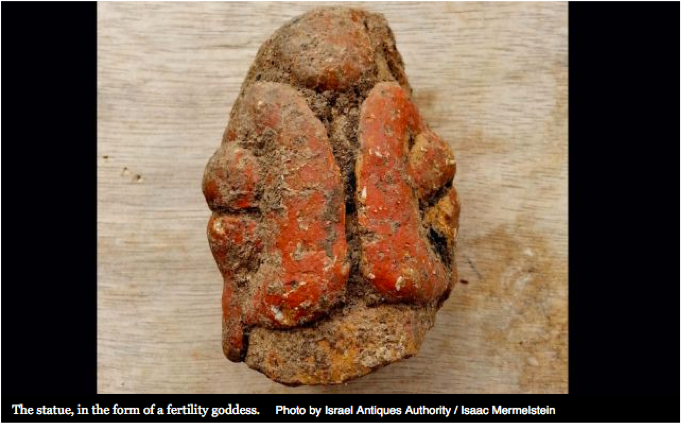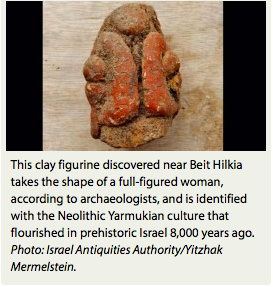Asherah’s Neolithic Ancestress? - Haaretz Article
"New archaeological finds challenge ideas of prehistoric Israel Neolithic fertility goddess figure found in rescue dig could change thinking about ancient cultures."

By Nir Hasson | May 7, 2015 | 4:52 AM | Haaretz Article | http://bit.ly/1FZmw24 | Thank you K.
“A small statue most likely used as a ritual object could change the view of archaeologists about the beginnings of the period of human settlement in the Middle East. The statue, in the form of a fertility goddess, was found in a rescue dig being conducted before the Mekorot water company lays a new pipeline close to Moshav Beit Hilkia, near Gedera in south-central Israel.
Remains from three prehistoric periods were found in the dig. The oldest have been dated to about 7,000 years ago. during the Pottery Neolithic period. Archaeologists from the Israel Antiquities Authority also found a fired ceramic clay figurine of a full-figured woman.
The discovery brings the number of sites at which similar figures from the period have been found to nine, mostly around Sha’ar Hagolan. Of the 163 such figurines found so far, two were found elsewhere - one in Lod and the other at Horvat Ptora, a site near Kiryat Gat and the one found now as said, in Revadim, near Gedera.
These figures are mostly attributed to what is known as the Yarmukian culture that flourished mostly in northern Israel about 7,500 years ago. This is a different culture than has been found in digs close to Beit Hilkia, such as at Revadim, known as “Jericho 9.”
The differences between the cultures are best seen in the pottery they made. If in the past, archaeologists thought Jericho 9 replaced the Yarmukian culture, the more accepted theory today is that the two cultures existed at the same time, but in different areas: the Yarmukian in the north and Jericho 9 in the south.
The discovery of the figurines – clearly Yarmukian – accompanied by the other two found in the region raises the question of the relationship between the two cultures.
“I think that in the end this is one culture with differences in the way pottery is made,” said Dr. Edwin van den Brink, who was in charge of the excavation along with Yitzhak Mermelstein. It is a big deal for the archaeologists, he said – but for the people who lived back then the differences were not so important. “It seems they had a single system of beliefs.”
“The question is whether the figurines represent a single ritual world in which there is an image with a bountiful chest, wide hips and maybe pregnancy,” said Marmelstein. “The most important question is whether the figures were made in the south or brought from the north.”
The archaeologists are now planning to conduct chemical tests of the statue to determine the source of the clay – whether it is from the north or south of Israel.”
Asherah’s Neolithic Ancestress? - Biblical Archaeology Article
According to a Biblical Archaeology Society article:
"Neolithic Figurine Could Lead to Reassessment of Prehistoric Israel"

"A small Neolithic figurine that may have been used for cultic purposes has been unearthed near Beit Hilkia in south-central Israel, Haaretz reports. Despite its size, the figurine’s presence in the region could have archaeologists rethinking the nature of the cultures living in prehistoric Israel some 8,000 years ago.
Israel Antiquities Authority archaeologists Edwin van den Brink and Yitzhak Mermelstein were conducting a salvage excavation ahead of the installation of a new pipeline when the Neolithic figurine was discovered. The clay figurine takes the shape of a full-figured woman, according to Haaretz, and is similar to Neolithic figurines found in northern Israel, mostly around the site of Sha’ar Hagolan (“the Gate to the Golan”). These figurines are attributed to the Yarmukian culture that flourished in northern Israel around 8,000 years ago, during the Pottery Neolithic period (6400–5800 B.C.E.). The Yarmukian culture was the first in this region to produce pottery.
 Archaeologists Yosef Garfinkel and Michele Miller describe the human figurines discovered at the Neolithic settlement of Sha‘ar Hagolan in an Archaeology Odyssey article:
Archaeologists Yosef Garfinkel and Michele Miller describe the human figurines discovered at the Neolithic settlement of Sha‘ar Hagolan in an Archaeology Odyssey article:
The most common—and engaging—human figurines are seated clay figurines with cowrie-like eyes. We have five complete, or nearly complete, examples, along with 70 fragments of various body parts. Each body part was made separately—head, torso, right leg, left leg. The components were assembled to create the basic figurine. Then small details were added: Eyes, ears and nose were put on the head; a veil was placed over the nape of the neck; arms, breasts and clothing were added to the body; fingers and fat folds were created by using different incision techniques; and the navel was depicted by a puncture mark. Remaining patches of paint on the figurines indicate that sometimes the entire figurine was painted red, while at other times only specific parts of the body were painted with red lines. The use of the color red—which is often associated with blood, and thus with life and fecundity—on these figures is intriguing. With one exception, all the anthropomorphic figurines represent women.
How were these figurines used? Probably for some cultic function. Were they fertility talismans, made to assure the fruitfulness of flocks and fields? Did they represent some sort of deity to be worshiped, perhaps a mother goddess? Or were they representations of beloved ancestors, used in an ancestor cult? No one knows. What we can say is that they appeal to our modern aesthetic sense.
 Many scholars believe that there was another distinct culture living in south-central Israel during the time that the Yarmukian culture flourished in northern Israel. The ceramic repertoire of this culture based in south-central Israel is identified with that found in Stratum IX at the site of Jericho; the culture is therefore referred to as “Jericho IX culture” or “Lodian culture.”
Many scholars believe that there was another distinct culture living in south-central Israel during the time that the Yarmukian culture flourished in northern Israel. The ceramic repertoire of this culture based in south-central Israel is identified with that found in Stratum IX at the site of Jericho; the culture is therefore referred to as “Jericho IX culture” or “Lodian culture.”
What makes the figurine found near Beit Hilkia remarkable is that it is attributed to the Yarmukian culture, but was excavated in the region where the Jericho IX culture flourished.
“I think that in the end this is one culture with differences in the way pottery is made,” excavation codirector Edwin van den Brink told Haaretz. “It seems they had a single system of beliefs.”
“The question is whether the figurines represent a single ritual world in which there is an image with a bountiful chest, wide hips and maybe pregnancy,” explained excavation codirector Yitzhak Marmelstein. “The most important question is whether the figures were made in the south or brought from the north.”
According to Haaretz, the archaeologists plan to test the composition of the figurine’s clay to determine whether it came from the north or south region of prehistoric Israel."